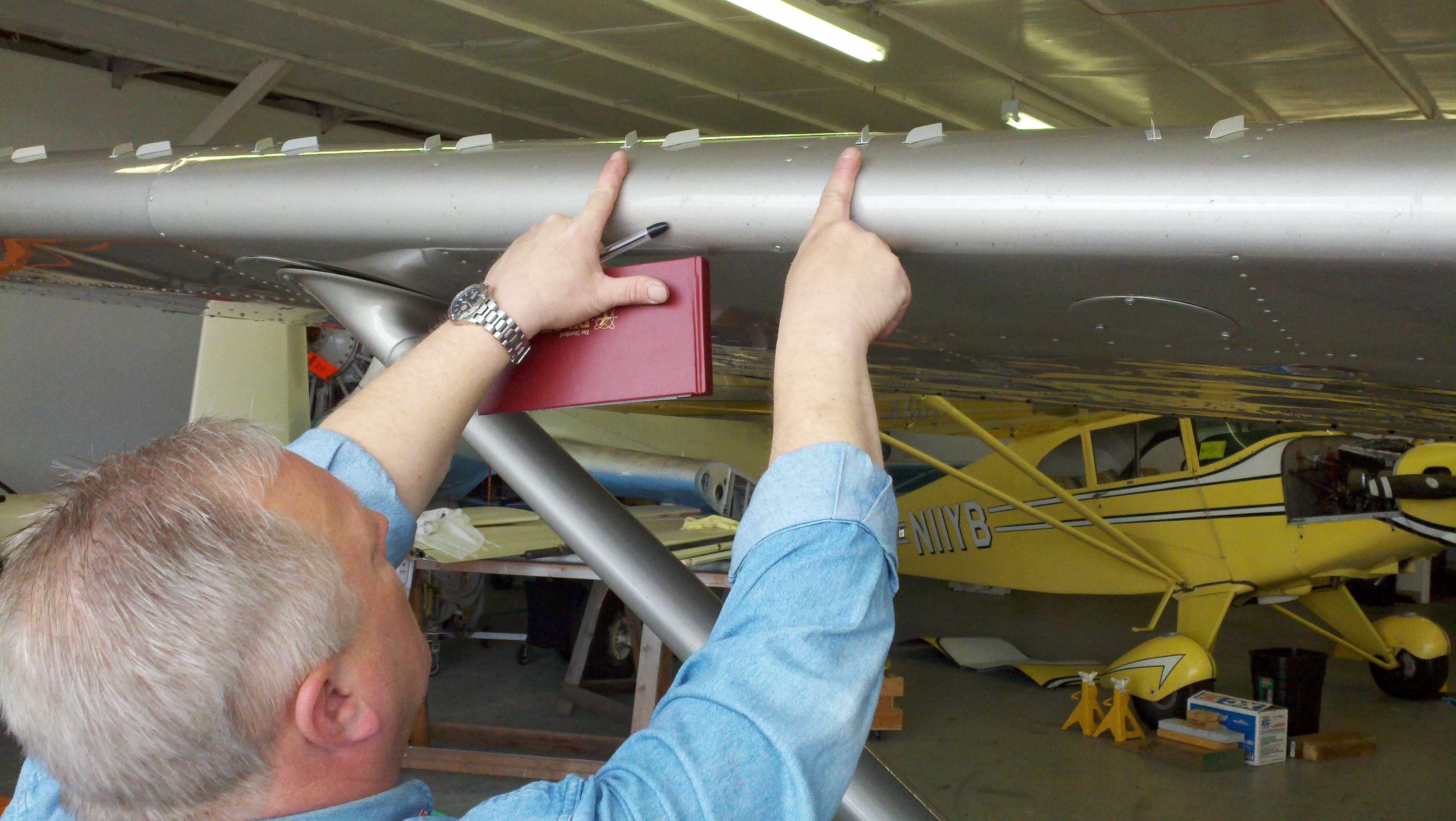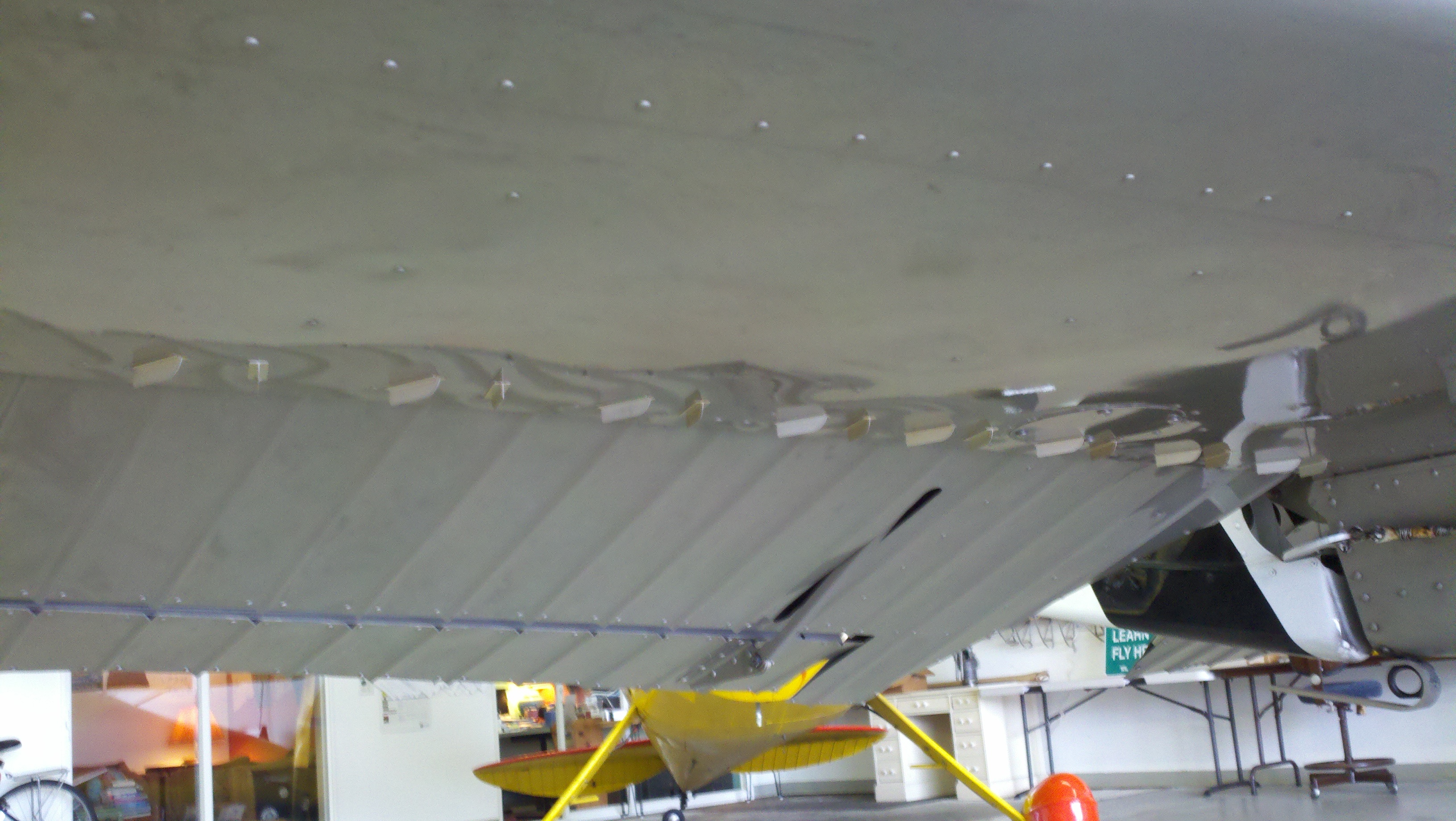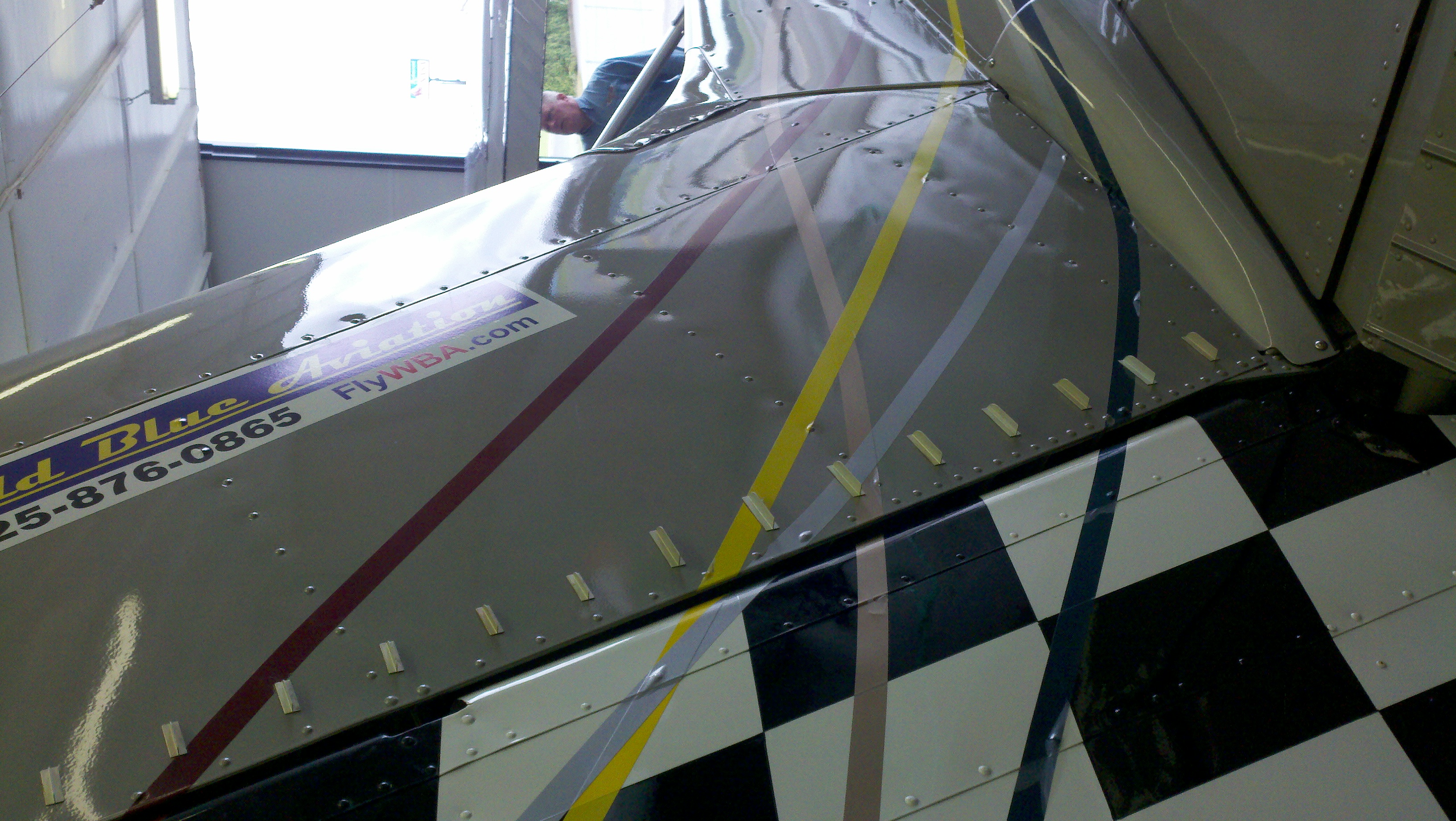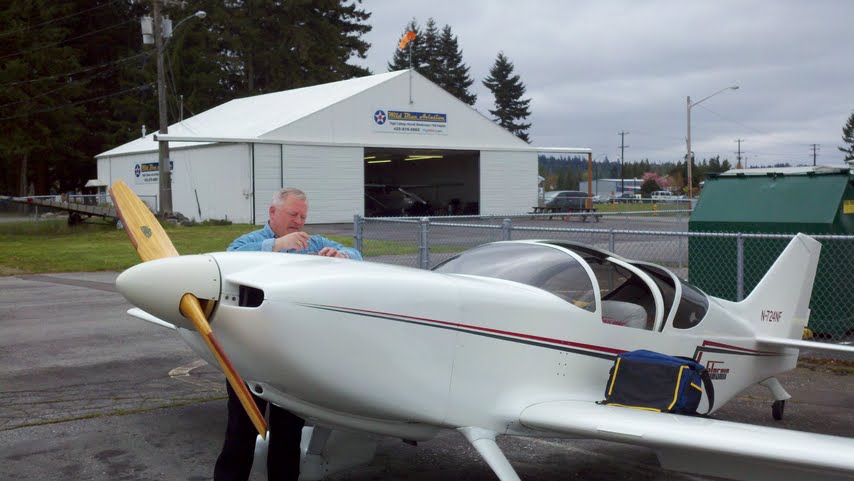|
|
 |
|
What's Happening?
Want to add your own something
to my web page? Now you can! Just click on the link below and I'll add your message to this page. Got something
you want to say about flying technique, maintenance, a news item, stories, pictures, got a question or just want to tell the
world about that great flight you just made to Alaska or about a recent fly-in or how you scared yourself silly? Speak
UP!
Just click here and get
to it! Wild Blue Blogosphere
|
 |
|
|
Tuesday, May 10, 2011
Yesterday when Bob Granley was here we got to talking VG's (Vortex Generators). You've probably seen them on the
tops of airliner wings. They're just little t-section pieces of plastic or aluminum placed at an angle to airflow that
impart a bit of energy at spots that need a little boost to get the to air behave better. They work miracles. Bob wants to
put some on his Glasair.
I put some on my Cessna 172 last winter, hoping to get better rudder response and maybe lighten up the pitch forces a
bit. I also expected a reduction in stall speed. I got the kit from Micro Aerodynamics in Anacortes, WA, http://www.microaero.com/, which is what Charlie White calls his business. The kit is very easy to install. They are mounted on the wings a few inches
aft of the leading edge, on the bottom side of the horizontal stabilizer just forward of the elevator hinge line and on the
verrtical stabilizer just forward of the rudder hinge line. The VG's not only make the rudder and elevator more effective
and reduce the stall speed by about 10%, they also make the stall much more benign. You can hold the stick all the way back
and the airplane just sits there, maybe a little hobby-horse nose bob, with fully effective rudder and ailerons. The indicated
stall speed is ridiculously low, about 25 knots indicated, actually well below the graduated range of the airspeed indicator! Of
course, that just shows how inaccurate the pitot-static system is at high angles of attack. The important thing is that
it used to indicate almost 50 knots (flaps up) and now its clear down at the bottom of the range with much better control
response. Fantastic! Give Charlie a call to put a little magic on your airplane.   
Monday, May 9, 2011
Bob Granley's Glasair
Bob Granley came by today for a Flight Review. After the usual ground review we took a ride in his just acquired
Glasair TD. Bob traded his trusty clip-wing Super Cub for it, requiring a flight from Point Roberts, WA, to Binghampton,
NY, 36 hours worth round-trip. You don't see many of these early Glasairs and very few have tailwheels. It cruises along at
about 170 indicated, has nice light controls, but is pretty short coupled and not for the faint of heart on the runway. FUN! 
Thursday, May 5, 2011
What can be done to improve Flight Training and Safety?
Yesterday and today the Society
of Aviation and Flight Educators (”SAFE”) has been hosting a Flight Training Reform Symposium in Atlanta to discuss “lack of growth,
decreased student start, increased student attrition, and flat accident rate trends vis-à-vis our current flight training
system.” Unfortunately, I have to work for
a living so can’t attend, but wish I could. See http://www.pilottrainingreform.org/.
There has been lots of talk for many years about improving flight
training and safety. Airplane hardware and software, like everything else these days, have undergone some amazing changes
and improvements, mostly avionics and displays. Glass panels may be nice to have, but are no substitute for the pilot pushing
the buttons, most airplanes don’t have them and they have an entirely new set of problems that have actually increased the accident rate. All those buttons and colorful displays are still attached to a stick and rudder
being manipulated by a pilot who is still too often the weak link in the whole operation. So, sad to say, no real help
on that front. Flight Reviews have been required for a long time now, but haven't had much effect on pilot skills or safety. Many,
many pilots lack basic stick and rudder skills, to say nothing of the judgment and skill required to deal with demanding situations. Amazingly,
most pilots, once they have their pilot certificate, don't pursue additional training of any kind. AOPA has done some
interesting research recently, showing the student pilot dropout rate is even worse than suspected, nearly 80%. Light Sport
airplanes and Sport Pilots haven't worked the miracles some hoped for. Of course the economy is in the doldrums, fuel
prices keep going up and airplanes keep getting more expensive, which undoubtedly have an effect on how much flying pilots
can afford, to stay current and safe, let alone pursue additional training to improve and expand skills. But that doesn’t
change the fact that regardless of cost or the economic environment, flying has always been pretty unforgiving of pilot
error, even in the most prosperous of times: there is no substitute for pilot skill and judgment when the crunch comes. All
of us who’ve been around for any length of time have had friends killed in airplanes. The question is what to do about it,
how to design and implement training that provides the skill and judgment to prevent experiences none of us wants to have.
As I’ve said on this blog and in an article published by the
National Association of Flight Instructors, flight training is not just a business in the usual sense. It’s not about “sales.”
Airplanes aren’t commodities like copper or pork bellies and student (or any other) pilots aren’t just “customers.” Flying
may be pretty easy, most of the time, if you’ve mastered and maintained the required skill set and have the judgment required
to stay safe. But the situations can literally be as variable as the weather. Some airplanes are simple, some not so simple.
Flying around the local vicinity snatching up $100 burgers with your buddies in a Cessna 172 is not the same as an IFR
(or VFR) flight over serious terrain or to unfamiliar places, especially in nasty weather, and even more especially in
an airplane you’re not intimately familiar with. Getting stuck someplace because of weather is no fun, but sometimes the best
alternative is to keep the airplane on the ground. The range of pilot certification available, Sport, Recreational, Private,
Commercial, ATP, CFI, plus all of the add-on ratings, covers a pretty broad range of training, designed to incrementally add
to a pilot's skills. Most of us don't have A&P certificates, mechanical experience or training, at least as far as relates
to the airplanes we fly, but that's a pretty handy skill set to have, too. Most of us
don't take advantage of any of the additional training available. But almost any pilot, regardless of training
(or lack thereof), certification level, ratings or experience can hop in an airplane with a load of family and friends and
head out wherever adventure calls. Usually it’s a lot of fun, but sometimes more than expected, and maybe even more than you
can handle. None of us wants to die in an airplane, let alone kill family and friends. It’s supposed to be fun, right?
Take a look at the Symposium web site
http://www.pilottrainingreform.org/. Even, if like me, you couldn’t attend, there are some pretty interesting items on the agenda worthy of consideration. I’d
love to hear your thoughts.
Email me at FlyWBA@gmail.com.
Tuesday, May 3, 2011
My View
This
article was published in the May 2011 edition of The Mentor, journal of the National Association of Flight Instructors
In a previous life I was a Land Surveyor. It's what I did to pay the rent and then the mortgage,
pay for flight training, feed the kids, buy the cars and pay the tuition. It was a lot like flight instructing,
which I did full-time for a few years, starved to death and reverted to part-time while I worked at joining the American
middle class. Both flight school and land surveying businesses tend to be relatively small, dependent on clients
who generally don't have and don't want to spend a lot of money, but demand a high degree of competence and value, while simultaneously
expecting the consultant--the CFI, flying school or surveying business--to accept a potentially high (if remote) level of
risk. And every land surveying business has the same set of problems as flying schools: not enough business,
the weather, the economic cycle, lots of on-the-job training required, employee turnover, high start-up cost and overhead.
Now that the kids are grown, my wife has a good job (big smoocherinos to you sweetie pie!) and we have
a little bit of security, I've gone back into the flight training business full-time, the sole proprietor of a one-man flying
school. The pay is still pretty poor and the hours are long, but you know what? I love it! After fifteen years
I'm still at it and still love it. But I have lots of advantages compared to the usual flying school and other CFI's:
I have no debt; no employees (so low overhead and no turnover), I'm an A&P so I can do most of my own maintenance
and I have no ambitions of "moving up" to the big iron. I like what I do and am proud to say I'm pretty good at it.
Both surveyors and flying schools/CFI's grouse about the low pay and are continually being advised to
be more "professional," to look sharp, have a nice office with a comfy customer lounge and to provide a high level of
"customer service"; to spend more effort on "sales," to recruit and retain "customers;" and to keep up with the latest and
greatest. They say "success" is a function of having the right business strategy.
Sorry, but I don't buy it.
Call me a stick in the mud, but I operate out of a hangar with a small office in back; the door is always
open and I'm here seven days a week. I never close. My airplanes are kept inside, are clean and squawk free and
are sometimes being serviced or otherwise maintained right out in the open where everyone can see and even participate in
the action. Students are shown what's under the cowling, how to change oil, put air in the tires and gas in the tank. They
help me give them a bath on nice days and vacuum the insides out; cleaning the windshield is part of training. I don't have
a pretty secretary or bookkeeper and I don't take credit cards. But we bar-b-que brats and dogs on sunny days and have
beer in the fridge (other things, too) for leveling the wings at the end of another great day of flying. I help folks maintain
their airplanes and usually don't charge them for a little help and supervision. I spend hours and hours just sitting around
talking airplanes with my friends--flyin' buddies, current and former students. I don't push Light Sport or glass panels.
Nothing against them, but let's be honest: its mostly just sales talk. Airplanes is mostly just airplanes. I don't
throw around buzzwords like "scenario-based training" or the latest FAA acronyms. And I can't quote FAR by paragraph number
(tho I can look them up). I think a bit of "macho" attitude is more than just desirable, its a necessity. Hey, this flyin'
stuff requires a little bit of a self reliant mind set, dontcha know? I'm a regular customer at the airport coffee shop, don't
wear a white shirt with epaulettes or a tie, or shiny shoes. I wear clothes that are comfortable and that I don't mind
getting a little dirt and oil on. I look like most of my customers, just a plain, regular guy. I don't tell people they
can learn to fly in twenty hours or lie about the real cost. I encourage them to buy their own airplanes to save money and
enjoy the pride of ownership—might make a little money, too. Then I teach them
how fly and maintain their new airplane. I proudly call myself an airport bum.
I concentrate on seeing to it my students understand and can do basic stick and rudder flying, can handle
crosswinds and actually move their feet. We fly needle, speedle and airball, use paper charts and look out the window.
And we keep the ball in the center (unless we have a better idea), hold a heading, altitude and airspeed. Tailwheels
are a Good Thing. So are rainy, nasty VFR weather, gusty winds and a little dirt under the finger nails. We fly over mountains
and water. And we love to take a bunch of airplanes to Reno for the races. We like round engines and aerobatics,
gliders and floats, old airplanes and even some a them airplanes from furrin' countries, too. Experimental airplanes
are cool, as are low and slow. We fly for fun, even if some of us do it for a living. I don't worry about getting my airplanes
wrecked because I don't let folks fly beyond their skill level. I monitor everything my students do so I can help them
become better pilots, keep the sheet metal straight and live to tell the tale. I don't do "customer service," I
don’t have to: my "customers" are my friends.
When I ask folks why they fly with me many say "You don't look or act like you're trying to sell me
something. And you don't charge me for every minute I'm here." I don't need to because flying sells itself and I love
talkin' airplanes. Flyin' is what I do. Almost all of my students finish the program and keep on flying with me
for many years, always "training", no rentals. This ain't Avis or Hertz. Folks literally call and come from all over
the world to fly my little Cessna 140 (apparently tailwheel instruction is hard to find), to talk gliders, Nanchangs and Yaks.
I do what I like to do, messing around with airplanes and flyin' folk. I don't expect to make a bunch
of money; just enough is fine by me. I enjoy being an airport bum.
There's nothing I would rather do.
Jerry Painter
Wild Blue Aviation
|
|
click here to download "The Ballad of Flight Service" song
|
 |
|
|
 |
|
|
 |
|
|
|
|
 Wild Blue Aviation Wild Blue AviationHangar 28
18228 59th Dr. NE, Arlington, WA, 98223 USA
Arlington Municipal Airport (KAWO)
mail to: 1521 Wetmore Ave., Everett, WA 98201-2057,
USA
|
|
|
 |

